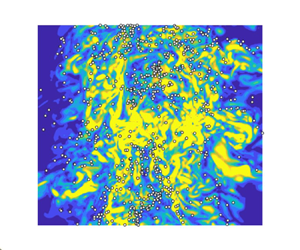Published online by Cambridge University Press: 13 October 2022

Point-particle direct numerical simulations have been employed to quantify the turbulence modulation and particle responses in a turbulent particle-laden jet in the two-way coupled regime with an inlet Reynolds number based on bulk velocity and jet diameter  $({D_j})$ of ~10 000. The investigation focuses on three cases with inlet bulk Stokes numbers of 0.3, 1.4 and 11.2. Special care is taken to account for the particle–gas slip velocity and non-uniform particle concentrations at the nozzle outlet, enabling a reasonable prediction of particle velocity and concentration fields. Turbulence modulation is quantified by the variation of the gas-phase turbulent kinetic energy (TKE). The presence of the particle phase is found to damp the gas-phase TKE in the near-field region within
$({D_j})$ of ~10 000. The investigation focuses on three cases with inlet bulk Stokes numbers of 0.3, 1.4 and 11.2. Special care is taken to account for the particle–gas slip velocity and non-uniform particle concentrations at the nozzle outlet, enabling a reasonable prediction of particle velocity and concentration fields. Turbulence modulation is quantified by the variation of the gas-phase turbulent kinetic energy (TKE). The presence of the particle phase is found to damp the gas-phase TKE in the near-field region within  $5{D_j}$ from the inlet but subsequently increases the TKE in the intermediate region of (5–20)Dj. An analysis of the gas-phase TKE transport equation reveals that the direct impact of the particle phase is to dissipate TKE via the particle-induced source term. However, the finite inertia of the particle phase affects the gas-phase velocity gradients, which indirectly affects the TKE production and dissipation, leading to the observed TKE attenuation and enhancement. Particle response to the gas-phase flow is quantified. Particles are found to exhibit notably stronger response to the gas-phase axial velocity than to the radial velocity. A new dimensionless figure is presented that collapses both the axial and radial components of the particle response as a function of the local Stokes number based on their respective integral length scales.
$5{D_j}$ from the inlet but subsequently increases the TKE in the intermediate region of (5–20)Dj. An analysis of the gas-phase TKE transport equation reveals that the direct impact of the particle phase is to dissipate TKE via the particle-induced source term. However, the finite inertia of the particle phase affects the gas-phase velocity gradients, which indirectly affects the TKE production and dissipation, leading to the observed TKE attenuation and enhancement. Particle response to the gas-phase flow is quantified. Particles are found to exhibit notably stronger response to the gas-phase axial velocity than to the radial velocity. A new dimensionless figure is presented that collapses both the axial and radial components of the particle response as a function of the local Stokes number based on their respective integral length scales.